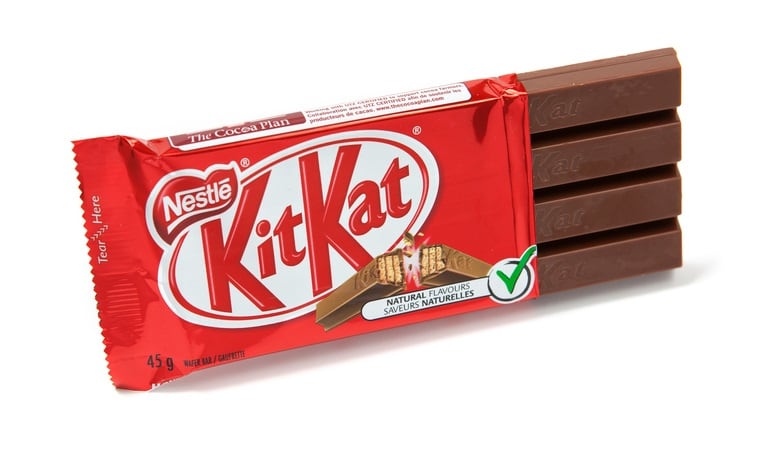A trademark is a word, phrase, symbol, logo, or product configuration that identifies the source of a product.
The success of a mark as a source identifier depends on consumer recognition, developed in large part by the marketing efforts of the owner, together with placement on the so-called spectrum of distinctiveness.
Distinctiveness
A word mark must be inherently distinctive or have acquired distinctiveness to merit trademark protection.
Inherently distinctive (strong) marks include fanciful, arbitrary, and suggestive marks.
Fanciful mark
A fanciful mark is an invented or coined word created expressly to function as a trademark, for example “Haribo” and “Twix.”
Arbitrary mark
Arbitrary marks include words in common use that do not describe or suggest the product on which the mark is used, such as “Snickers” and “Air Heads.”
Suggestive mark
A suggestive mark, such as “Almond Joy”, suggests but does not directly describe an aspect, feature, or ingredient of the product.
Marks that are not distinctive
Marks that are not inherently distinctive are weak and must acquire distinctiveness via long-term or extensive use, to qualify for protection.
Descriptive marks, such as “Ring Pop” and “Gummy Worms,” that describe some aspect of the underlying product, fall within this category.
Finally, a generic mark is one that cannot identify or distinguish the source of the product because it relates to the entire class of products and is incapable of trademark protection. “Chocolate Caramels,” for example, would be a generic mark.
What about logos?
Logos also can function as trademarks. Unlike word marks, logos are not placed on the spectrum of distinctiveness to determine if they are protectable.
Instead, a logo must simply be used in a way that consumers and competitors recognize it as identifying the source of the product, taking into account the design, symbols, fonts, and colors that comprise the logo.
Trademarking packaging
Finally, product configuration or packaging may operate as protectable “trade dress”.
Trade dress refers to a collection of definable elements that cause a label, wrapper, packaging, or the overall look of a product to function as a source identifier.
In most cases, trade dress must acquire distinctiveness as a result of long-term use to function as a source identifier and qualify for protection.
Shapes and designs
General product themes, common shapes, or functional designs are not protectable and may be deemed generic.
For example, a chocolate Easter rabbit, the shape of an ice cream cone, and a heart-shaped candy box are all generic, incapable of functioning as source-identifiers.
When to apply in the US
You should apply for trademark protection for inherently distinctive word and logo marks as early as possible.
In the US, you can file an application in advance of use, but obtaining a registration is contingent on use in interstate commerce.
For descriptive marks and trade dress, protection is only available once the mark has acquired distinctiveness as a source identifier.
International registration
International use or registration requires additional considerations.
Trademark laws in each country differ, and, for the most part, are independent of rights in other countries.
For example, priority of rights in the US are based on first use in US commerce, whereas in many other countries, the party that is first to file a trademark application has priority, and no proof of use is required to obtain a registration.
Design protection in the UK
Under US trademark law, protection does not exist for a product design unless it functions as a source-identifier - this is the trade dress/product configuration analysis discussed above.
Product designs must acquire distinctiveness and be non-functional to be protectable.
In contrast, UK trademark law provides relatively robust design protection.
Designs can be inherently distinctive, and even functional designs may be registered so long as the features of the product design are neither governed solely by technical function nor the sole way to accomplish that function.

A retreat?
Recent litigation in the UK, however, signals a possible retreat from this broad design protection.
In Société des Produits Nestlé SA v. Cadbury UK Ltd., the court of appeal found the shape of the Kit Kat bar is not inherently distinctive as a “badge of origin.”
The court distinguished between, on the one hand, the shape being well known to the public and, on the other, the public perceiving and relying on the shape as a designation of source.
As a result, Nestlé’s application for registration of the Kit Kat shape was denied.
In a second case, Poundland challenged Toblerone’s trademark in the triangular prism shape of its product (first obtained in Switzerland in 1909), after Toblerone owner Mondelēz warned Poundland that its Twin Peaks bar infringed the Toblerone trademark.
[Parna Mehrbani and Kelsey Benedick are attorneys for US law firm Lane Powell which specializes in trademark law with a focus on the food industry]
